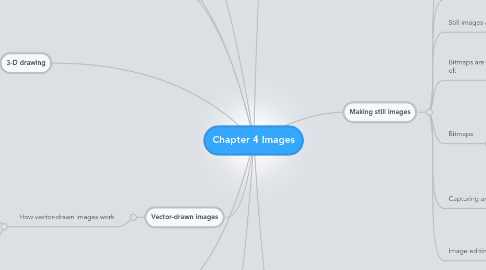
1. Vector Drawing
1.1. Vector-drawn graphics
1.1.1. Applications of vector-drawn object
1.1.2. How vector-drawn images work
1.1.3. Vector-drawn images versus bitmaps
1.2. Vector-drawn images are used in:
1.2.1. Computer-aided design (CAD)
1.2.2. 3-D animation
2. Vector-drawn images
2.1. How vector-drawn images work
2.1.1. A vector is a line that is described by the location of its two endpoints.
2.1.2. Vector drawing makes use of Cartesian coordinates.
3. 3-D drawing and rendering
3.1. 3-D animation tools
3.2. Features of a 3-D application
3.3. Panoramas
4. 3-D drawing
4.1. 3-D animation, drawing, and rendering tools include:
4.1.1. Daz3D
4.1.2. Form*z
4.1.3. Autodesk's Maya
4.2. Features of a 3-D application
4.2.1. Modeling
4.2.1.1. Placing all the elements into 3-D space.
4.2.2. Extrusion
4.2.2.1. The shape of a plane surface extends some distance.
4.2.3. Lathing
4.2.3.1. A profile of the shape is rotated around a defined axis.
5. Rendering
5.1. Use of intricate algorithms to apply user-specified effects.
6. Colors and Palettes in Multimedia
6.1. understanding natural light and color
6.1.1. Additive color
6.1.1.1. color is created by combining colored light sources in three primary colors-red, green and blue.
6.1.2. Subtractive color
6.1.2.1. color is created by combining colored media such as paints or ink.
6.1.2.2. Process used to create color in printing.
6.1.3. Color models
6.2. Color palettes
6.2.1. Palettes are mathematical tables that define the color of pixels displayed on the screens.
6.3. Dithering
6.3.1. process whereby the color value of each pixel is changed to the closest matching color value in the target palette.
7. Bitmap software
7.1. Adobe's Photoshop and Illustrator
7.2. Corel's Painter and CorelDraw
8. Making still images
8.1. Still images may be the most important element of a multimedia project.
8.2. Still images may be small or large, or even full screen.
8.3. Still images are generated in two ways:
8.3.1. Bitmaps (raster)
8.3.1.1. Bitmaps editors are called painting program.
8.3.2. Vector-drawn graphics
8.3.2.1. Vector editors are called drawing program.
8.4. Bitmaps are an image format suited for creation of:
8.4.1. Photo-realistic images
8.4.2. Complex drawings requiring fine detail
8.5. Bitmaps
8.5.1. A simple matrix of the tiny dots that form an image and are they displayed on a screen or printed.
8.5.2. Have varying bit and color depths.
8.5.3. made up of individual dots or picture elements known as pixels or pels.
8.6. Capturing and editing images
8.6.1. Capturing and storing images directly from the screen is another way to assemble images for multimedia.
8.7. Image editing programs enable the user to:
8.7.1. Enhance and make composite images.
8.7.2. Alter and distort images.
8.7.3. Add and delete elements
9. Image file types used in multimedia
9.1. MAcintosh formats
9.2. Windows formats
9.3. Cross-platform formats
10. Bitmap sources
10.1. Where do bitmaps come from?
10.1.1. Capture a bitmap using a camera.
10.1.2. Make a bitmap from scratch with a paint or drawing program.
10.2. Legal rights protecting
10.2.1. Public domain images
10.2.1.1. never protected by a copyright or their copyright has ended.
10.2.2. Royalty-free images
10.2.2.1. purchased and then used without paying addition license fees
10.2.3. Right-managed images
10.2.3.1. require you negotiate with the right holder regarding terms for using the image and how much you will pay for that use.

